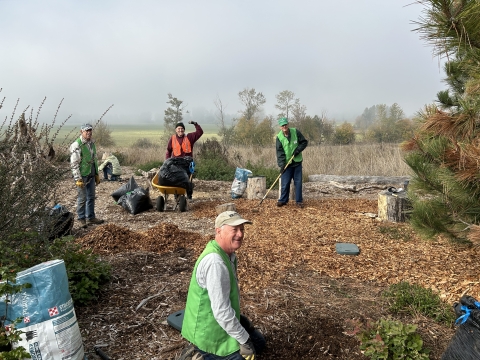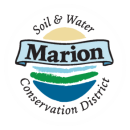Ways to Get Involved
National Wildlife Refuges partner with volunteers, youth groups, landowners, neighbors and local community members to make a lasting difference. Getting involved at Ankeny National Wildlife Refuge is a great opportunity to learn new skills and help to conserve our public lands. With a variety of opportunities in a wide range of programs, anything from visitor services to habitat management, there is a place for everyone to get involved.
The National Wildlife Refuge System is committed to building partnerships which encourage conservation and preservation of our natural and cultural resources. Partnerships with the Refuge System bring innovative approaches to solving land management and water disputes in the most environmentally protective manner. Scientifically-informed and technologically-based stewardship of our public lands, waters, wildlife and special places must be collaborative efforts between the Refuge System, other government agencies, and private organizations if conservation efforts are to succeed.
Volunteering
Volunteering for the U.S. Fish and Wildlife Service is a great way to engage in conservation work and get involved in the community. With volunteer opportunities in nearly every aspect of the refuge, there are a multitude of ways to gain new skills and meet new people.
Volunteers
More than 42,000 people volunteer their time and ideas each year to the U.S. Fish and Wildlife Service. Whether they work on the land, in a visitor center or with youth, they contribute to the conservation mission that reaches back more than a century. Become a volunteer or Refuge Friend to contribute your strength on behalf of America’s natural resources. Contact the Friends of the WVNWRC or Refuge staff to learn how you can get involved.
Ankeny Hill Nature Center Volunteer Program
The Ankeny Hill Nature Center has an active volunteer program, and we would love your help! Habitat Stewards, and Education, Interpretive, and Outreach Volunteers are just a few of the opportunities. Reach out to our Volunteer Coordinators for more information, orientation dates/times and community volunteer days: volunteer_manager@ankenyhillnaturecenter.org
Education, Interpretive, and Outreach Volunteers
Education, Interpretive, and Outreach volunteers have an interest in environmental education, local plant and wildlife species, ecosystems and habitats, and/or cultural history. Ability to effectively communicate knowledge to refuge visitors, and program and/or event participants.
Potential Responsibilities Include:
- Prepare materials for programs and events
- Share info about the Nature Center and Refuge at the Welcome Table
- Present scheduled programs
- Assist schools and community groups with educational programs
- Attend and table outreach events in local communities
Habitat Stewards
Habitat Steward volunteers have an interest in local plant and wildlife species, gardening, ecosystems and habitats, and/or cultural history. Ability to walk up to 1+ miles along refuge trails, using tools and materials to pick-up trash, remove weeds, and perform other general habitat maintenance as needed.
Potential Responsibilities Include:
- Clean-up trash along trails & viewpoints
- Identify maintenance needs at the Nature Center
- Remove invasive weeds
- Plant native plants
- Spread wood chips
- Load, unload, and move materials and tools as needed
Community Volunteer Days (Third Saturday of each month from 10:00am - 12:00pm)
Help with conservation, education, and restoration efforts by participating in regularly scheduled volunteer days every third Saturday of the month from 10:00am - 12:00pm. Projects typically include invasive plant management, trash removal, or preparing environmental education and interpretive materials.
This is a great way to participate in environmental stewardship, meet others in the community who enjoy the outdoors, and get behind-the-scenes looks at the refuge. No need to register for the Community Volunteer Days, just show up with a desire to learn and assist!
Our Partners
Partners for Fish & Wildlife
The mission of the U.S. Fish and Wildlife Service (USFWS) is, by working with others, to conserve, protect and enhance fish and wildlife and their habitats for the continuing benefit of the American people. Since 1987, the Service’s Partners for Fish and Wildlife program has been accomplishing this mission by offering technical and financial assistance to private landowners to voluntarily restore a variety of fish and wildlife habitats on their land.
Our Focus
The Partners for Fish and Wildlife program in the Willamette Valley focuses on restoring oak woodland, savanna, grassland, riparian riparian
Definition of riparian habitat or riparian areas.
Learn more about riparian , wetland, and wet prairie habitat and the 22 at risk species, including the 11 listed species, which depend on them. These declining habitat types support unique and significant biological diversity yet they are primarily in private ownership.
Our efforts are part of a large-scale restoration initiative to increase awareness of native habitats, restore diversity, contribute to recovery of listed species, benefit key migratory bird habitats, enhance valuable open space and preserve the historic character of the Willamette Valley in a manner compatible with its present day uses.
Our Partners
The USFWS works with a wide variety of partners to restore wildlife habitat on private lands. These partners include other federal agencies, Tribes, state and local governments, conservation organizations, academic institutions, businesses and industries, school groups and private individuals.
Our Invitation
Over 70 percent of our Nation’s landscape is in private ownership. The health of our fish and wildlife populations depend on habitat on private lands. To get involved or for further information, contact your nearest National Wildlife Refuge.
Your Willamette Valley and the American Great Outdoors Initiative
"Lasting conservation solutions should rise from the American people." This is the overarching premise of the America's Great Outdoors Initiative, enacted in April 2010. Also central to the initiative is the understanding that the appreciation and protection of our national heritage is an objective shared by all Americans.The Valley AGO project took shape in 2011, with the creation of the Willamette Valley Conservation Study. The U.S. Fish & Wildlife Service has been entrusted with the coordination of this study, which covers a geographic area that includes the valley floor and foothills to about 1,500 feet in elevation. Over 100 communities, including the five largest cities in Oregon and numerous farms, ranches, and forests, are located within the Study area. After a period of input gathering from many other government and non-government organizations, as well as private land owners, the Conservation Study is moving forward with a set of focus topics that represent the most abundant concerns we've heard in discussions of conservation throughout The Valley.
Other Partner Organizations
Locally, the Willamette Valley National Wildlife Refuge Complex staff regularly partner with various different organizations. Here are just a few of our partners:
- Friends of the Willamette Valley NWRC
- Mid-Willamette Bird Alliance
- Salem Audubon Society
- Marion Soil and Water Conservation District
- The Greenbelt Land Trust
- Oregon State University Extension Service
Friends
More than 200 nonprofit Refuge Friends organizations support National Wildlife Refuges, whether they work with a single refuge, a refuge complex or an entire state. Friends members are crucial to conserving and protecting our nation’s wildlife and teaching millions of Americans that their actions today determine the conservation legacy of tomorrow. The Friends of the Willamette Valley National Wildlife Refuge Complex support the refuges through work parties, educational programs, refuge events, and funds provided by the volunteer-run Wild Goose Nature Store in the Finley NWR administrative building.
Friends of the Willamette Valley NWRC
To learn more about the Friends of the Willamette Valley National Wildlife Refuge Complex and what they do on the refuges, check out their quarterly newsletter, The Wild Goose Tales.




